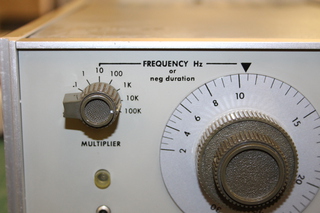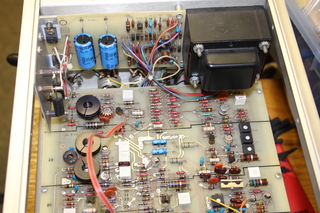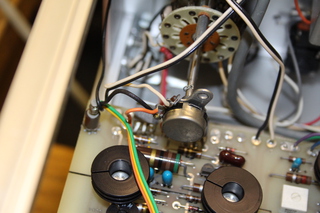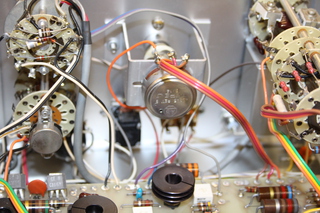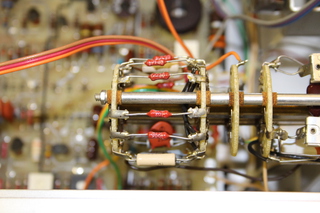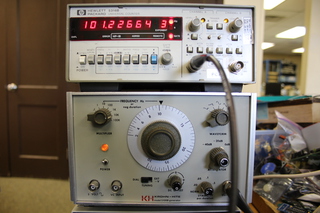Topic: Checkout and repair of a classic Krohn-Hite function generator
Date: 2023 FEB 13
Krohn-Hite is a fairly well-known name in the test equipment business, but seems to be lesser known amongst hobbyists. They’ve been producing high quality test equipment for almost 75 years. The 5100B function generator is one of their products from the 1970s:
Features
Despite being around 50 years old, this function generator is still a useful piece of test gear on a modern bench, and has some features that set it apart from some of the cheaper options out there. One of the features I use the most is the ability to go to very low frequencies:
Notice that the range switch has a 0.1 setting: this function generator can output from 0.002 Hz to 3 MHz! The lower end is especially useful for running circuits at human-observable speeds. This is something I’d often have to use a pulse generator for, otherwise.
In addition to sine, triangle, and square waves, the 5100B can also produce negative or positive ramps, as seen on the waveform selector switch:
As seen above, there’s also a stepped attenuator, which is handy when testing OP-AMP or other amplifier circuits. The control is dual concentric, with a pot on the center shaft. The usual procedure is to dial in an amplitude using the pot on the 0 dB setting, then switch down with the stepped attenuator. The 5100B can output up to 20V peak-to-peak into a high impedance input, or 10V peak-to-peak into 50 ohms.
There are also controls for DC offset and waveform symmetry, both of which include a switched position. For DC offset, the switched position sets offset to 0V, nulled via a pot on the back panel. The symmetry switched position sets duty cycle to 50%, which is also trimmable at the back panel:
On the back, we can also see the BNC sync input, which allows the 5100B to phase lock to an external source.
Aside from the tuning dial on the front, the 5100B can be tuned electronically, using a control voltage supplied through a front panel BNC (VC INPUT). With the TUNING switch in the DIAL position, the dial selects the center frequency, and a control voltage at the VC INPUT can shift the frequency up and down by 5%.
With the TUNING switch in the EXT -V position, frequency is directly controlled via the VC INPUT. A negative voltage from -15mV to -15V selects a frequency in the range chosen by the range switch. Positive control voltages stop the oscillator.
The main difference between the 5100A and 5100B seems to be the power input: the 5100A uses an attached power cord, and the 5100B uses an IEC connector. The 5100A also uses a cheese head screw for the frequency pointer, while the 5100B uses a printed arrow. I’m not sure if there are more differences, as I’ve been unable to find the 5100B manual. Krohn-Hite will usually email a copy of the manual for their instruments if you contact them, but the 5100A manual has been sufficient in getting my 5100B operational.
Repairs
My Krohn-Hite 5100B did require a few repairs to get it fully operational. First up, it got new electrolytic capacitors:
There’s a pair used for bulk filtering on the rear-mounted supply board, and a pair for decoupling/bypass in the middle of the main board. I used standard axial values we had in stock, rather than trying to exactly match the capacitance and voltage rating of the originals. If a piece of test equipment is being opened for service, I’ll generally recap if it’s an older unit: it’s not worth having to open the instrument again for a failure, and there’s always the risk that a shorted capacitor will burn up a rectifier and/or transformer winding, or that an open cap will allow enough ripple through to destroy something else.
The next repair item was the level pot, which is the center shaft in the dual-concentric attenuator control:
This pot was very noisy, and would not maintain a stable output at any position other than fully clockwise (max output). It was removed from the unit (unbolted in the above picture) and opened. On this particular 5100B, the pot was not glue sealed, so the tabs were bent back and the pot was fully disassembled. Inside, there was some nasty green buildup, and a hardened layer of gunk on the resistance element. This was removed with swabs and isopropyl alcohol. The track was then lightly abraded with an ink eraser. A small amount of De-Oxit Gold G5 cleaner was applied – this is what Krohn-Hite has recommended for control cleaning during previous interactions. The pot shaft was lubricated with a little light machine oil, and reassembled. This completely eliminated all noise when using the inner control on the attenuator.
The frequency pot was also noisy, though not as bad as the level pot. It did not provide smooth tuning while moving, but did not exhibit noise when stationary. It is coupled through a resilient fitting to the vernier dial on the front:
Unlike the level pot, this one is a Allen Bradley Type J, which is a glue-sealed unit. It’s not possible to open these pots without a big risk of destroying the resistance element. Since it’s sealed, there’s no way to get a shot of contact cleaner in there. The other option was replacing it, so I decided to try drilling some holes into it:
I drilled two small holes in the back cover of the pot. To avoid drilling too deeply and striking the resistance element, I chucked a pin vise into the electric drill, and set the drill bit so that there was only maybe 1/8 inch of stick-out. Two holes were drilled: one to allow contact cleaner to enter, and the other to act as a vent – remember, it’s sealed, so trying to spray into a single hole will just make a mess! De-Oxit Gold G5 was sprayed in through the larger hole, and the control was worked back and forth a few times. This seems to have worked, and now the 5100B tunes smoothly!
The rear deck of the frequency range switch required a little contact cleaner for one of the positions, but it’s easy to access:
Here’s an overall picture with the covers removed, it’s a very nicely built piece of equipment:
Dial Calibration
I haven’t fully calibrated the front panel frequency dial on my 5100B, but did get it “close enough” after removing the frequency pot for drilling:
The HP 5316B Universal Counter sitting on the Krohn-Hite 5100B contains an ovenized oscillator (Option 004, OCXO) and is a pretty accurate counter. Rough calibration of the front panel dial was accomplished by setting the function generator to approximately mid-scale, loosening the resilient coupling between the vernier dial and frequency pot, and tweaking the frequency pot until the counter read 150 kHz. The setscrews on the coupling were then tightened.
As seen above, it’s not quite spot-on, but it’s pretty close. The manual covers proper calibration, which will probably be performed at some point. I usually operate dial-controlled function generators or oscillators with a counter, so dial accuracy is not super critical.
Video Overview of Functionality
bap8guy has a video on YouTube covering features of his Krohn-Hite 5100B:
His channel includes videos of many other pieces of vintage test equipment, as well as some newer items.
Hz triangle wave

